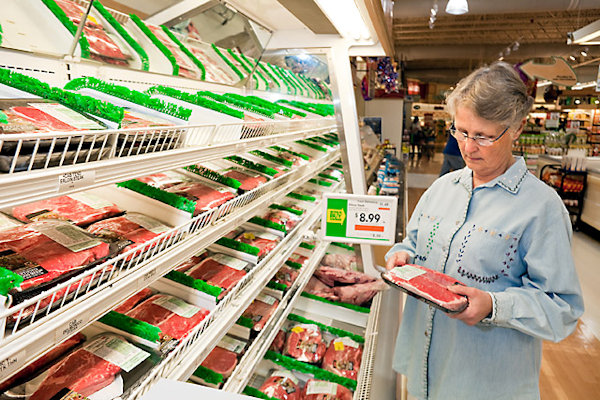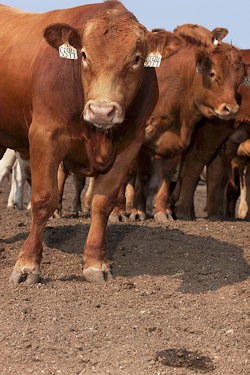SEJournal Online is the digital news magazine of the Society of Environmental Journalists. Learn more about SEJournal Online, including submission, subscription and advertising information.
 |
 |
| The largest contributor to food sector carbon emissions is livestock farming, particularly for beef. Photo: USDA, Stephen Ausmus. |
Feature: Eat Local for Climate’s Sake? No, Eat Less Meat
By Jenny Splitter
First of two parts on food and climate
How we eat can significantly reduce our carbon footprint, but the most effective ways to do that aren’t always so clear.
One very common and persistent myth is the notion of locavorism as a climate solution. This is the idea that the best way to reduce emissions from food is to get it from local sources, whether that be growing food in your backyard, shopping at farmer’s markets or sourcing directly from local farmers.
It’s not that there aren’t benefits to eating food grown in your community. There are plenty — supporting local economies, the health benefits of eating fresh fruits and vegetables, or even just the incomparable satisfaction of successfully growing your own tomatoes, to name just three.
But according to the data, climate emissions savings is not one of those benefits. Let me explain.
The underlying assumption is that emissions from the food system come mostly from fossil fuels used to transport food over long distances. Yet the evidence shows that transportation emissions pale in comparison to other sources. Using data from a study of 38,700 farms that was published in Science in 2018, Hannah Ritchie, a data analyst at Our World in Data, showed that transportation accounts for just 6% of overall emissions from the food sector.
The reason shipping foods
isn’t a bigger source of emissions
is that the industrial food system
is highly efficient.
The reason shipping foods all over the country and the world isn’t a bigger source of emissions is that the industrial food system is highly efficient, particularly in how it transports products. (That efficiency comes with other trade-offs, particularly for animal welfare, but right now I’m just talking about greenhouse gas emissions.) It’s much like how bus travel is more climate-friendly than going by car.
Cattle burp methane, a potent greenhouse gas
What isn’t a myth is that the largest contributor to food sector emissions is livestock farming, particularly for beef, but also for dairy, as well as lamb.
That’s primarily because cattle and sheep are ruminants — amazing digesters that produce a lot of methane as they break food down. This methane is usually in the form of burps, not farts by the way, and is functionally the same as industrial methane from natural gas.
Methane traps more heat in the atmosphere per molecule than carbon — making it as much as 80 times more harmful — yet it’s also more short-lived. What that means is methane sticks around for only around 10-12 years before it breaks down, as compared to the 100 years or more for carbon.
As a result, many climate scientists argue for reducing methane emissions now as a strategy for buying the planet a bit more time to address some of the more challenging fossil fuels.
The climate costs of land
 |
| Beef cattle in a feedlot at Clay Center, Nebraska. Photo: USDA, Peggy Greb. |
The other reason beef has such a huge climate cost comes down to land. Cattle require lots of land for grazing, as well as a massive amount to grow soy and corn for feed crops.
But the climate impact of land is more than what we do with it now. Some food system researchers also measure the cost of our future land use choices, building in what they call “carbon opportunity costs” to their models.
As Ritchie explains for Our World in Data, “An opportunity cost is the potential benefit you’re giving up by choosing one option over the other. Every decision you make has an opportunity cost — you could be spending your time or money on something else.”
The decisions we make with land are the same. The choice to clear a forest or any other native landscape releases greenhouse gases into the atmosphere. But the reverse is also true: a choice to "rewild" farmland sequesters carbon, taking it out of the atmosphere.
Of course, it wouldn’t make sense to rewild everything. We need farms to feed people. But knowing the carbon opportunity cost of different foods can help us make better decisions about what to farm and where to rewild. For example, a lot more land is required to produce beef than lentils, beans and tofu, which means the carbon opportunity cost will be a lot higher.
What does a climate-friendly diet look like?
The question of what diet is the best for curbing emissions often sparks fierce debate, especially when the story is focused on absolutes — like pitting veganism against the meat-centric carnivore diet.
While there is little doubt that going vegan has massive environmental benefits, you don’t have to join the elite who don’t eat meat to adopt a more climate-friendly diet. Plant-based protein sources like lentils, beans, nuts and seeds all come with a fraction of the carbon footprint of animal proteins and, again, especially beef.
So, what does a climate-friendly diet look like? Climate scientists with the Intergovernmental Panel on Climate Change, World Resources Institute, EAT Lancet and Project Drawdown all recommend eating less red meat — WRI quantifies this as around 1.5 beef burgers per week or less — and shifting to a plant-forward diet.
Researchers have also found that some people eat a lot more meat than others. Populations in the Global North consume far more meat than those in the rest of the world.
In the United States, one study found
that just 12% of the population
is eating 50% of all the beef.
And in the United States, one study found that just 12% of the population is eating 50% of all the beef. Those eating a disproportionate share included middle-aged adults, people who identified as white or Hispanic and men.
There’s also evidence some people are already eating less meat, or at least trying to. Some studies show diets that allow wiggle room rather than eliminate meat, like reducetarianism and flexitarianism, may be on the rise.
All sorts of market forces play a role too. The United States still consumes more meat than the global average, but the Department of Agriculture is forecasting meat consumption rates to decline just slightly in the next year, by about 1% (Sentient Media recently did a deep dive on why that might be).
Meanwhile, meat-eating is on a steeper decline in the United Kingdom and Germany, though it’s not clear if this is motivated by environmental or animal welfare concerns.
Animal agriculture, an often-overlooked part of the climate story
Despite the research on meat and its climate impact, climate news stories often leave the food system out of the coverage.
Out of 1,000 climate stories published by national outlets like The New York Times and The Washington Post, 93% never mentioned emissions from livestock, even though emissions from meat and dairy are responsible for between 10% and 20% of all global emissions.
Unpacking the myths and realities of diet-related greenhouse gas emissions is just one way to cover the environmental impacts of animal agriculture. In Part 2, I’ll talk about six other potential angles.
Jenny Splitter is an award-winning food and climate journalist for outlets such as The Guardian, Vox, Everyday Health, Undark, Popular Mechanics, The Washington Post and New York Magazine, and the editor-in-chief of Sentient, a nonprofit news outlet covering factory farms and their impact on food, climate, health, policy and more.
* From the weekly news magazine SEJournal Online, Vol. 9, No. 10. Content from each new issue of SEJournal Online is available to the public via the SEJournal Online main page. Subscribe to the e-newsletter here. And see past issues of the SEJournal archived here.












 Advertisement
Advertisement 



